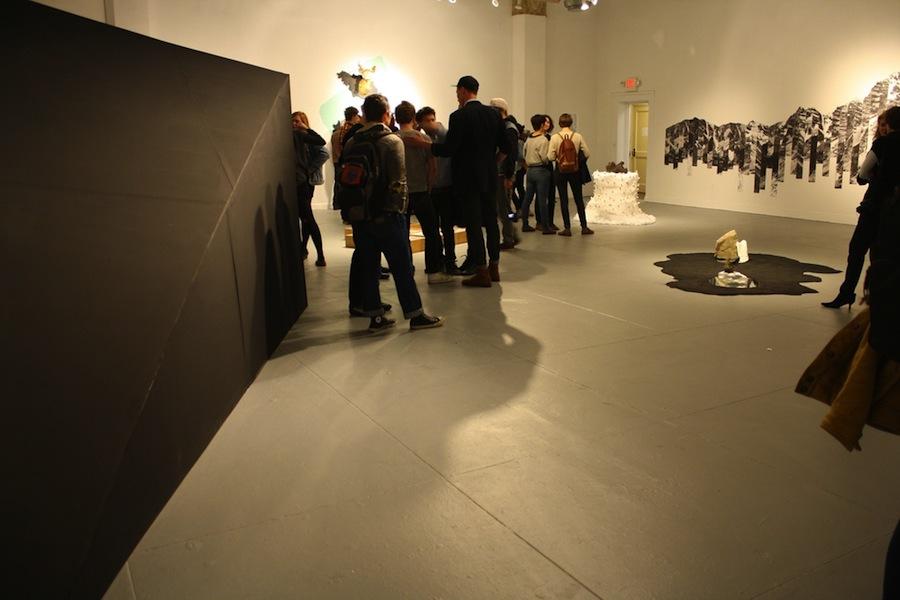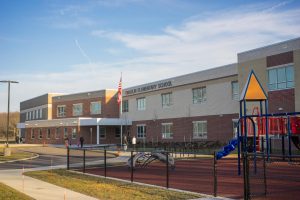Senior Studio Duo Leads Viewers Through Earth in New Light
College seniors Devra Freelander and Lucas Briffa brought nature into the gallery, offering a type of organic experience within Fisher’s architectural container.
May 4, 2012
This last week marked the 42nd Earth Day, a worldwide holiday to increase awareness and celebrate the Earth’s natural environment. Many honor this holiday, which takes place annually on April 22, by planting trees, holding garage sales, educating themselves about the environment or simply spending a relaxing day in the sun. College seniors Lucas Briffa and Devra Freelander, however, celebrated our planet five days after the rest of us, through a more abstract, artistically deconstructive manner, however, with their Senior Studio show Through Earth.
While the majority of Briffa’s work occupied the east side of Fisher Gallery and Freelander’s the west, the duo came together and created a cohesive transition between the opposing sides of the room. In the center of the gallery, two pieces in particular wove their media together: “Time Appears,” a projection of a photographed landscape onto a white sheet housed in a gigantic black hollowed-out triangular structure, and “Second Crust,” a compilation of wooden boxes with cup-up photographs that were collaged onto the top of them. These two works staged a physical connection between the duo’s media, as Briffa’s focus is photography and Freelander’s is sculpture.
Briffa’s portion of Through Earth investigated the deconstruction and reconstruction of space through a pastiche of appropriated images that created new landscapes. Lining the west wall of Fisher Gallery was the piece “Found Landscapes,” in which he hung two groupings of a series of pictures, constructed by hand through precise cutting and pasting. Working in black and white as well as color, he erected breathtaking, majestic landscapes; one affecting image showed mountain tops breaking through clouds set against a crisp blue sky with a strip of lightning. By layering the papers atop one another, he created texture and a kind of delicacy unmatched by conventional photography. “In this liberating [move]… from the classical photographic process,” Briffa described in his artist statement, his art “demands a presence of mind that is … perceptual. It rewards the patient, the receptive, and those willing to examine the surface.” Those ideas were reflected in the small scale of the pictures, which forced audience members to interact closely with them in order to view them. Upon inspection the work was unmistakably skilled and served Briffa’s ambition to alter the viewer’s understanding of how space is perceived — if only for those with the patience to engage with the miniatures.
In contrast, Freelander’s sculptures literally jumped out of the wall. “Permeate” was the most physically prominent piece Freelander contributed to the installation. In it, she fastened a deer’s head to the east wall of the gallery, backed by black material against a larger baby blue shape, with three smaller black cutouts below. Addressing Freelander’s desire to create “microcosmic mineral kingdoms,” as she described in her artist statement, a number of rocks jutted out of moss that grew in patches on the deer’s head and neck. The intent of such construction, as was the same in all of Freelander’s other sculptures, was to use these “minerals” in order to “heighten the viewer’s awareness of the permeable boundaries separating the living and nonliving.” “Permeate” certainly achieved this; however, other pieces, such as those that involved a chair or black sand, for example, were less effective — perhaps too literal in manifesting the concept of “nonliving.”
Despite some aspects of the show being too soft or too loud, Through Earth was successful in coming together as a cohesive Senior Studio show, a difficult feat to achieve with two artists. The duo accomplished what it sought out to do, transforming Fisher Gallery into an exploration and celebration of the earth, far beyond any predictable perception, with the artists leading us to see our natural surroundings in new light.


















